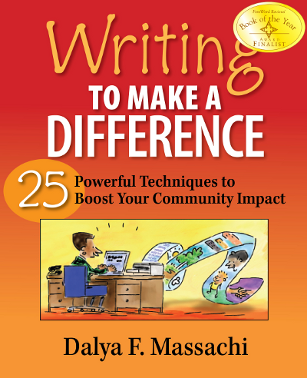 [Dalya’s Note: This is an excerpt from my award-winning book, Writing to Make a Difference: 25 Powerful Techniques to Boost Your Community Impact.]
[Dalya’s Note: This is an excerpt from my award-winning book, Writing to Make a Difference: 25 Powerful Techniques to Boost Your Community Impact.]
Your readers want to be inspired by the world you would like to see. Your organization, of course, will play a role in realizing that vision—so help your readers visualize it right now.
![]() Ask yourself: If your organization were to meet with great success and fully accomplish its mission, what would that look like?
Ask yourself: If your organization were to meet with great success and fully accomplish its mission, what would that look like?
You may want to ask this simple question of your colleagues as well. Perhaps your organization even has a formal “vision statement.”
******
Examples
Here are a few vision statements of values-based organizations:
1) Foundation Center: A world enriched by the effective allocation of philanthropic resources, informed public discourse about philanthropy, and broad understanding of the contributions of nonprofit activity to increasing opportunity and transforming lives.
2) Global Exchange: We envision a people centered globalization that values the rights of workers and the health of the planet; that prioritizes international collaboration as central to ensuring peace; and that aims to create a local, green economy designed to embrace the diversity of our communities.
******
You might also develop a more informal image of what you are working toward. For instance, some organizations have held community gatherings or stakeholder retreats to paint murals or assemble collages representing the world they want to create.




